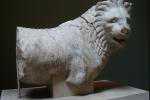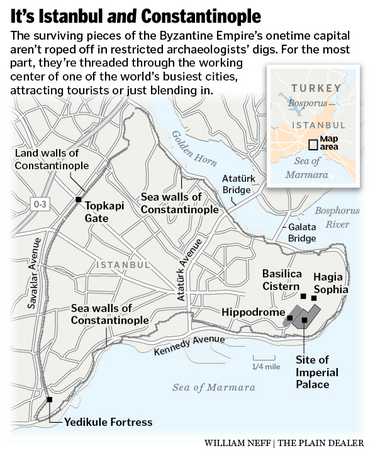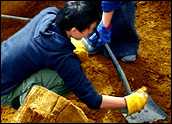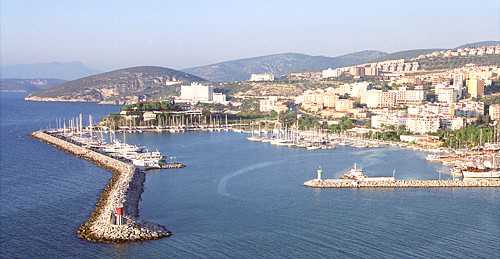BY Ceylan Yeginsu | January 14 2013 2:01 PM
Turkey is one of the world’s richest countries when it comes to archeology. Located at the crossroads of Europe and Asia and with a history of human habitation that dates back to the dawn of civilization, it’s especially rich in ancient Greek ruins that were created when the land that is now Turkey was known as Asia Minor, or Anatolia.

(Photo: Wikipedia)
A lion from the Mausoleum of Halicarnassus in the British Museum
But many of those priceless relics aren’t in Turkey; they’re in Western museums. Now Turkey is trying a bold new tactic to recover them: It plans to use human rights law to get them back.
The country, which is usually divided on the sensitive issue of human rights enforcement, has found common ground as lawyers, civil society and the government gear up to file a lawsuit in the European Court of Human Rights (ECHR) in an attempt to repatriate artifacts that are being housed at the British Museum.
The court, located in Strasbourg, France, normally tackles, as its name suggests, freedom of expression violations and torture cases. But Turkey will most likely put a unique spin on Article 1 of the First Protocol of the European Convention on Human Rights, filing suit against the British Museum on the grounds that “Every natural or legal person is entitled to the peaceful enjoyment of his possessions.”
This is yet another installment in Turkey’s campaign to restore its cultural heritage. Museums worldwide are being pressured by the country to return antiquities that once belonged to ancient Anatolia. The subjects of the most recent case are sculptures that once adorned the Mausoleum of Halicarnassus, one of the Seven Wonders of the ancient world, in the city that is now modern-day Bodrum.
“We are very grateful to the British Museum for housing these artifacts for all these years, but is it not natural for us to want them back? Is it not our right?” said lawyer Remzi Kazmaz, who joined forces with the Mugla Bar Association and the Turkish Ministry of Culture to bring the case to the attention of the ECHR.
“We may not have the best track record when it comes to preservation, but we now have the power to protect and facilitate these items,” Kazmaz added.
Kazmaz declined to comment on the measures that have been taken to carry the case to the ECHR, but he said that “all the appropriate steps have been taken and some 30 lawyers will act on behalf of the town of Bodrum in this case.” A petition with 118,000 signatures will also be presented to the court.
As Turkey prepares to file the case on Jan. 30, the British Museum says it has not been contacted directly regarding the lawsuit. “We have not heard anything directly about the legal case, other than via a media enquiry, so we can’t comment on it as we are not aware of the details,” said Olivia Rickman, press and PR manager of the museum.
According to Rickman, the sculptures from the Mausoleum of Halicarnassus in the Museum’s collection were acquired in 1846, 1857 and 1859. “These pieces were acquired during the course of two British initiatives, both with firmans [legal permits issued by the Ottoman authorities] that granted permission for the excavation of the site and removal of the material from the site (1857 and 1859) and Bodrum Castle (1846) to the British Museum,” Rickman said.
“The Mausoleum of Halicarnassus is one of the Seven Wonders of the ancient world and these pieces have been displayed at the British Museum in the context of presenting world cultures to a global audience,” she added.
Turkey, however, contests that the objects are in Britain legally. “The British Museum says [it has] permission, but [it does] not. There is no valid documentation,” Kazmaz said.
Charlotte Woodhead, an expert in cultural heritage law at the University of Warwick in England, is not aware of human rights legislation ever being used before to reclaim such objects. “If a claim is brought before the European Court of Human Rights, it will be interesting to see on what basis it is argued and also to see what the outcome is,” she said.
Besides using human rights legislation, Turkey has also turned to an Ottoman-era law banning the export of artifacts to threaten museums such as the Louvre in Paris, the Getty in Los Angeles and New York’s Metropolitan Museum of Art, which have been displaying ancient Anatolian artifacts for years.
“We are showing respect to history. We are not just asking for Ottoman or Seljuk artifacts; I am also laying claim to pieces from the Roman period or the pagan period. Why? Because we are aware that safeguarding your history, archeology and your museums is an element of development,” Culture Minister Ertugrul Gunay told the Hurriyet Daily News last year.
He explained that Western museums have been criticizing Turkey for not knowing the value of these artifacts in the past, but that Turkey is now aware of their importance.
“There was a lack of awareness in the past. But today, the world has reached a certain level of development and we have caught up with that level of development, and we are now establishing museums above world standards,” he said.
Turkey’s Ministry of Culture has opened 10 new museums in the past five years, with an additional 19 projects underway. Excavation projects are also fully underway, and the results will be safeguarded in new exhibits within Turkish museums, according to the Ministry.
The ministry has not yet commented on the ECHR case, but according to Kazmaz, it has played a significant role in preparing the lawsuit. “We aren’t expecting the British Museum to just hand everything back, but we want to open a dialogue so we can at least be active in preserving these artifacts, whether it means we can jointly house them for 10 years at a time or longer. We are open to negotiation,” he said.



